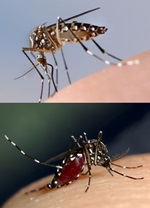Chikungunya virus

Chikungunya is spread to people through the bite of infected mosquitoes, most often Aedes aegypti and Aedes albopictus. This disease is not spread in Connecticut; however, residents can acquire it by traveling to foreign endemic areas. Outbreaks have occurred in Africa, Asia, Europe, areas of the Indian and Pacific Oceans, Central and South America, and the Caribbean. In Connecticut, surveillance is conducted to identify travel-related cases. There is no vaccine to prevent or medicine to treat chikungunya virus infection. The best way to prevent getting sick from chikungunya virus is to prevent mosquito bites.
Where Has Chikungunya Virus Been Found?
Information for Clinicians
National Surveillance Case Definition
Connecticut Provider Reporting Information
Connecticut Laboratory Reporting Information
Directory of Clinical Testing Services provided by the State Public Health Laboratory
State Public Health Laboratory Contacts – for additional information
Connecticut Chikungunya Surveillance
The Connecticut Department of Public Health (DPH) added Chikungunya to the list of state-wide reportable diseases in 2015. In Connecticut, surveillance is conducted to identify travel-related cases. An average of 6 cases (range 0 to 16) have been reported to DPH annually.
Connecticut Annual Infectious Diseases Statistics
This page last updated 9/9/2022.

